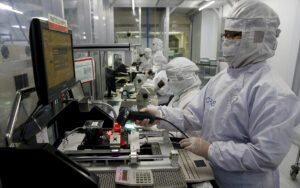




Monthly Economic Update: One for the road
 DOWNLOAD
DOWNLOAD

Inflation Update: Still low, still slow
 DOWNLOAD
DOWNLOAD

Philippines Trade Update: Exports momentum continues
 DOWNLOAD
DOWNLOAD


Factory activity highest in 7 months

FACTORY ACTIVITY in the Philippines continued to expand, hitting a seven-month high in January, as firms ramped up production levels due to an uptick in foreign demand.
The S&P Global Philippines Manufacturing Purchasing Managers’ Index (PMI) rose for a third straight month to 53.5 in January from 53.1 in December. This was the Philippines’ highest PMI reading since 53.8 in June 2022.
A PMI reading above 50 denotes improvement in operating conditions compared with the preceding month, while a reading below 50 signals deterioration.
 “Operating conditions across the Filipino manufacturing sector improved solidly during January, according to the latest PMI data. Sharp upturns were noted in both output and new orders, as panelists cited increased demand for Filipino manufactured goods,” Maryam Baluch, economist at S&P Global Market Intelligence, said in a report released on Wednesday.
“Operating conditions across the Filipino manufacturing sector improved solidly during January, according to the latest PMI data. Sharp upturns were noted in both output and new orders, as panelists cited increased demand for Filipino manufactured goods,” Maryam Baluch, economist at S&P Global Market Intelligence, said in a report released on Wednesday.
The headline PMI measures manufacturing conditions through the weighted average of five indices: new orders (30%), output (25%), employment (20%), suppliers’ delivery times (15%), and stocks of purchases (10%).
The Philippines had the second-highest PMI reading among six Association of Southeast Asian (ASEAN) member countries, just behind Thailand (54.5) and ahead of Indonesia (51.3).
On the other hand, factory activity in Myanmar (49.6), Vietnam (47.4) and Malaysia (46.5) contracted during the month.
Overall, the ASEAN manufacturing sector jumped to a three-month high of 51 in January, from 50.3 in December.
STRONGER DEMAND
S&P Global noted a sharp rise in production levels, which expanded for a fifth month in a row.
“Anecdotal evidence pointed to increasing demand for Filipino manufacturing goods. Similarly, new orders also rose at a faster pace in January,” it said.
Foreign demand for Philippine-manufactured goods also rose in January.
“Growing international client numbers and stronger demand from China helped revive exports for the first time in 11 months,” S&P Global said.
Firms increased purchasing activity in January, with the pace of expansion one of the quickest on record.
Manufacturing companies also posted an increase in the level of unfinished work in January, which S&P Global said was only the fifth month of improved work backlog since January 2016.
“For the first time in a year, holdings of post-production inventories fell as firms utilized stocks to meet higher new orders,” it said, adding the drop was “slight.”
Despite stronger demand, S&P Global noted price pressures eased further in January.
“The pace of input price inflation was the slowest in two years and below the survey average, with charges levied also rising at a softer rate than that seen in over a year,” it added.
Ms. Baluch noted that the Bangko Sentral ng Pilipinas’ (BSP) aggressive tightening was effective as prices continued to ease in January.
“Encouragingly, demand has yet to be impacted negatively by policy changes,” she said.
The BSP raised rates by a total of 350 basis points (bps) last year. BSP Governor Felipe M. Medalla earlier signaled a 25- to 50-bp hike at the central bank’s first policy meeting of the year on Feb. 16.
“Additionally supply chain pressures also eased further, with panelists citing that improved infrastructure, more vendors and lifting of port restrictions helped with delivery times,” Ms. Baluch said.
However, hiring activity remained slow in January.
The S&P Global report showed the seasonally adjusted employment index edged closer to the 50 neutral mark, indicating only a fractional rise in employment numbers in January.
ING Bank N.V. Manila Senior Economist Nicholas Antonio T. Mapa said improved supply chain conditions and demand helped boost factory output in the first month of 2023.
“Supply chain conditions also (eased), which helped keep production costs down, a sign that the economy continues to reopen. Demand (was) also evident, notably also from abroad, which bodes well for export orders,” he said in a Viber message.
“The one disappointment would be the lack of pickup in labor market improvement as hiring was largely flat,” he added.
Rizal Commercial Banking Corp. Chief Economist Michael L. Ricafort said that the reopening of the economy drove manufacturing activity higher.
“The latest local manufacturing PMI gauge generally improved in recent months amid measures to further reopen the economy towards greater normalcy,” he said in an e-mail.
Mr. Ricafort added that the boost in foreign and local tourism also supported the recovery of businesses, including some manufacturers. – Luisa Maria Jacinta C. Jocson, Reporter
This article originally appeared on bworldonline.com





 By BusinessWorld
By BusinessWorld